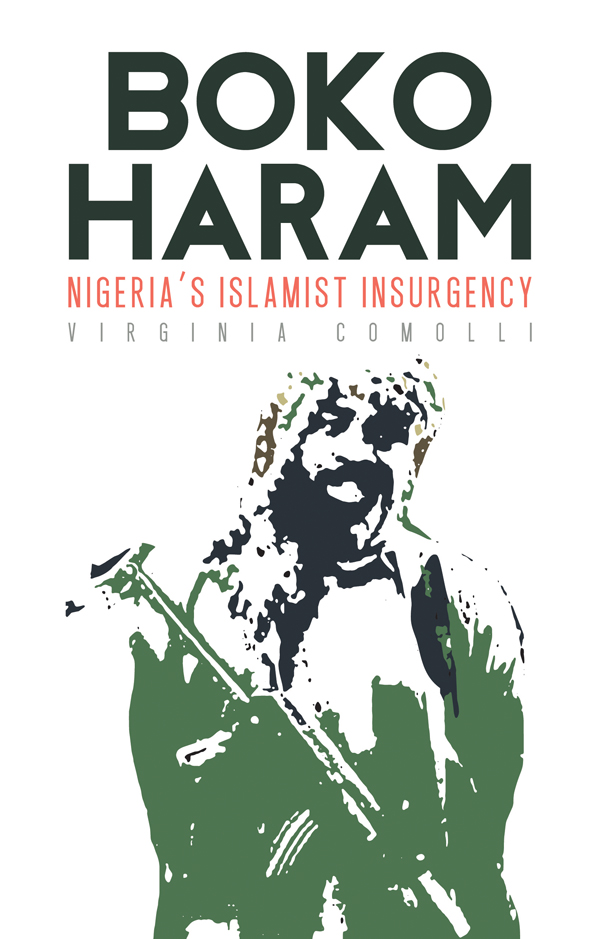|
Reviewed by Benjamin Arah, Ph.D., Associate Professor of Government & Philosophy, Bowie State University Comolli, a research fellow for security and development at the London International Institute for Strategic Studies, has added an invaluable voice to the growing literature on Boko Haram (Lilley, 2015; Smith, 2015; Perry, 2014; River, 2015; Simons, 2015; Zenn, 2012; Ebiem, 2014; Davieson, 2014; Murtada, 2013; Cook, 2011). Boko Haram, a violent militant and Islamic extremist group of Sunnah in Northeastern Nigeria and contiguous neighboring countries (Chad, Cameroon, Niger), has evolved (since 2002) and for years gone almost unchallenged until becoming Africa’s most jihadist threat to regional security and economic development. Comolli eloquently presents a rigorous interpretive analysis of the group’s complicated history with a unique perspective on the deep-rooted causes (cultural, religious, ideological, political, economic) with rapid radicalization leading to unspeakable atrocities and indiscriminate attacks “on civilian and military targets, with Christians and Muslims alike killed with what seemed like relish” (2015, p. 1). Her book is a “must-read” that provides a critical insight to African political and religious leaders, policy-makers, and military strategists, and other key stakeholders to examine and address the factors responsible for the discontent, marginalization, and radicalization of Africans in the continent which has been exacerbated by their poverty of leadership. The book has seven chapters and an epilogue. Chapter 2 provides a historical background of Islam, and Chapter 3 focuses on the emergence of the various radical Islamist groups in the northeastern part of Nigeria with competing ideologies, influences, and their strategic use of religion for political ends. Chapter 5 centers on “The Internationalization of Boko Haram” (pp. 85-107), and Chapter 4 focuses on the question of “What is Boko Haram?” (pp. 45-84). In Chapter 4, Comolli sets out to discuss “Boko Haram’s tactical and ideological evolution from an isolated, mostly peaceful, religious community, to a violent insurgency that embraces suicide attacks and hostage-taking” (p. 45). Because of its convoluted and complicated history and militancy, Nigerians were not able to understand the group (as cultural, religious, ideological, and political Islamist insurgency). Determined to conquer and “Islamize” Nigeria (or dip the Koran into River Niger), the jihadist group would reject all “un-Islamic” traditions and stop at nothing till the establishment of an Islamic state based on the Sharia law and rejection of democracy (with Western values). As a matter strategy against Christians or other infidels, the militants resorted to violence, terrorism and use religion as a way “to take up arms to protect their interests” (p. 50). Comolli’s book is well-researched, timely with important updates, refreshing and clearly written for an easy read. Unlike authors before her, Comolli is persuasive and balanced in her attempt to (a) highlight the historical roots and other forces that enabled Boko Haram to become a violent militant insurgency; and (b) explain how the Federal Government (under the former President Goodluck Jonathan) failed to provide political vision and the military strategy to respond appropriately to the increasing Boko Haram violence that continued to metastasize in that part of the world. The author acknowledges the public failure to understand Boko Haram phenomenon, earlier on, which resulted in the poverty of political leadership coupled with the failure to allocate sufficient national resources to snuff out the jihadist group out of existence (for political stability, religious tolerance, and economic development). Comolli was critical of President Jonathan’s inability to lead and Nigeria’s ineffective military response to deal with Boko Haram (a national menace). She writes that “a significant part of this book is devoted to understanding the government response to the insurgency…most of the political class has proved unable to offer an effective response to the violence” (pp. 3-4). Today, Boko Haram, which Comolli defines as “a violent Islamist movement waging an insurgency campaign that includes terrorist tactics such as suicide attacks” and engaged in “the use of more sophisticated weapons” (p. 153), continues to constitute a serious threat to security, humanitarian, and economic well-being of Nigerians and neighboring countries. This is a threat that must be dealt with and hopefully eradicated. Africans look up to President Muhammadu Buhari for real solutions, and he has vowed to “technically” defeat the militant groups. Even if President Buhari and other African leaders succeed in crushing Boko Haram, that will not be logically sufficient without a responsible effort to address the root causes and abuses that underlie the grievances, economic inequality, and feelings of social injustice. |


 Boko Haram: Nigeria’s Islamist Insurgency
Boko Haram: Nigeria’s Islamist Insurgency